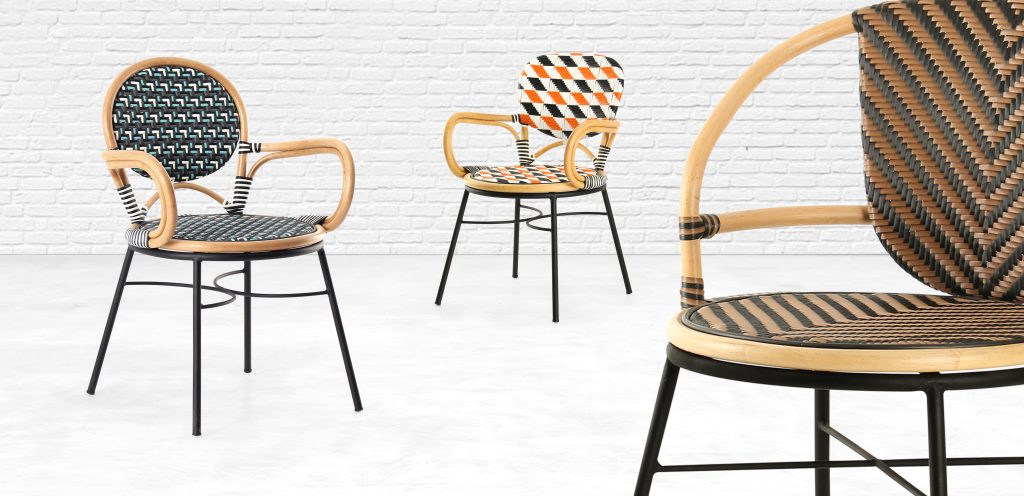Outdoor chairs have become a staple of modern outdoor living. They aren’t just seating; they are part of a lifestyle—whether you’re basking in the sun on your patio, enjoying a quiet evening on your balcony, or entertaining guests in your garden. Choosing the right outdoor chair isn’t just about style but also about durability, comfort, and adaptability to the elements.
In this guide, we’ll explore the major types of outdoor chairs and the materials commonly used, highlighting what makes each option special and how they perform in outdoor settings.
Exploring Different Types of Outdoor Chairs
When it comes to outdoor chairs, each type has its own character and purpose.
Adirondack chairs are perhaps the most iconic, known for their wide armrests and slanted seat design. They’re made for relaxation, often placed around fire pits or facing beautiful garden views. Their design encourages you to lean back, stretch out, and forget your worries.
Lounge chairs are all about comfort. With their elongated shape and often adjustable backs, they’re ideal for poolside tanning or afternoon reading under the sun. Many include cushions for added support, making them a go-to for ultimate leisure.
Outdoor dining chairs are more upright in design and typically come in sets. Used alongside dining tables, they turn your patio or backyard into an open-air dining room. They’re often stackable for easy storage.
Rocking chairs bring a nostalgic charm to porches and shaded corners. Their rhythmic motion offers both comfort and stress relief. These chairs have a timeless quality and remain popular in traditional and rustic outdoor setups.
Folding chairs offer a practical solution for those who need flexibility. They’re lightweight, portable, and easy to store—perfect for extra seating during garden parties or spontaneous get-togethers.
Hanging or swing chairs bring a playful and cozy vibe to your space. Usually suspended from a beam or supported by a metal frame, these chairs offer a soothing swinging motion, making them ideal for both adults and kids who want a relaxing spot to unwind.
The Importance of Material in Outdoor Chairs
The performance and appearance of an outdoor chair are heavily influenced by the material it’s made from. Different materials not only shape the look and feel of your chair but also determine how well it withstands the elements.
Teak Wood: Timeless Elegance and Durability
Teak is one of the most prized materials for outdoor furniture. Sourced from tropical hardwood trees, teak is naturally rich in oils that protect it from moisture and insects. This built-in resistance means teak chairs can last for decades with minimal maintenance.
Over time, teak develops a beautiful silver-gray patina that adds character without compromising strength. Its dense grain and smooth texture give it a luxurious feel, and many designers prefer it for its ability to stay strong even in extreme climates. If you want furniture that blends elegance with endurance, teak is a superior choice.
Rattan and Wicker: Natural Texture with Modern Performance
Rattan chairs bring a touch of nature to outdoor settings, often featuring hand-woven textures that radiate warmth and charm. Traditionally made from natural vines, modern outdoor rattan chairs are usually crafted using synthetic materials to increase their durability against weather.
Synthetic rattan, also known as resin wicker, mimics the look of natural fibers but adds resilience. It resists UV rays, rain, and humidity. Rattan chairs are lightweight, easy to move, and offer a comfortable, breathable seating surface. Whether styled in bohemian, tropical, or coastal themes, rattan remains a versatile and visually pleasing option.
Aluminum: Lightweight and Rust-Resistant Innovation
Aluminum outdoor chairs are favored for their strength-to-weight ratio. These chairs are incredibly light, making them easy to rearrange or stack. Despite their lightness, they hold up well against the elements.
Aluminum doesn’t rust, which is especially useful in coastal or humid areas. Most aluminum furniture is powder-coated to enhance its appearance and increase resistance to scratches and fading. With a wide range of colors and sleek designs, aluminum chairs work well in both modern and traditional outdoor spaces.
Plastic and Resin: Affordable and Practical Solutions
Plastic and resin chairs offer a no-fuss approach to outdoor seating. They are among the most affordable options on the market and come in many shapes and vibrant colors. Made from molded polypropylene or other synthetic materials, these chairs are waterproof and fade-resistant.
Ideal for casual gatherings, they are often stackable and easy to store. While they may not carry the same aesthetic appeal as wood or metal, their convenience and functionality make them a smart choice for budget-conscious homeowners or event planners.
Steel and Iron: Strength and Sophistication
Metal outdoor chairs, particularly those made of steel or wrought iron, are known for their durability and weight. They stay put even in strong winds, making them excellent for exposed areas. Wrought iron in particular brings a classic and ornate touch to outdoor spaces, especially when paired with vintage or Mediterranean-style décor.
To prevent rust, these chairs are typically treated with protective finishes like powder coating. Regular upkeep may be necessary, especially in rainy climates, but their timeless look and structural strength make them worth the effort for many users.
Textilene and Mesh: Breathable Comfort with a Modern Edge
Some outdoor chairs feature mesh fabric seating, often stretched over a metal frame. This breathable material, commonly known as Textilene, provides a cool and flexible seat, making it ideal for warm climates or poolside use.
One of the biggest benefits of mesh is its quick-drying property. If it rains or someone sits down in a wet swimsuit, the chair dries quickly without holding moisture. The fabric conforms to the body for comfort and doesn’t require cushions, keeping the design minimalist and functional.
Concrete and Stone: Sculptural Statements with Ultimate Strength
While not as common in residential settings, concrete and stone chairs offer unmatched durability and a dramatic visual impact. These materials are often used in public spaces, luxury resorts, or modern outdoor installations where permanence and artistic form are desired.
They don’t require maintenance, resist all weather conditions, and will never warp, rot, or fade. However, due to their weight, they’re typically fixed in place and not suited for small or flexible arrangements. These chairs are ideal for creating bold, architectural outdoor focal points.
Choosing the Right Outdoor Chair Material
When choosing your ideal outdoor chair, it’s essential to consider the climate where you live, how much maintenance you’re willing to do, and the aesthetic you want to achieve.
For instance, those in coastal or rainy regions might prefer aluminum or synthetic rattan due to their resistance to moisture and corrosion. If low maintenance is your priority, plastic, aluminum, or powder-coated steel could serve you well. For homeowners looking for a luxurious, natural look that will stand the test of time, teak and synthetic wicker offer the best of both worlds.
Enhancing Your Outdoor Chairs with Accessories
No matter the material, outdoor chairs can be elevated with the right accessories. Cushions made from weather-resistant fabrics like Sunbrella add both comfort and color. Throw blankets, side tables, and umbrellas can help create a cohesive outdoor environment that feels just as cozy as your indoor spaces.
Incorporating these extras doesn’t just boost visual appeal—it extends the time you spend outside, whether for morning coffee, evening wine, or hours of reading and relaxing.
A Chair for Every Outdoor Dream
Outdoor chairs are more than functional—they shape how we enjoy our time outdoors. From laid-back lounging to sophisticated entertaining, the right chair brings both comfort and character to your space.
Each material offers something unique. Teak brings elegance and longevity. Synthetic rattan combines style with resilience. Aluminum offers lightweight durability. Plastic excels in practicality, while metal adds timeless strength. Mesh provides breathable comfort, and concrete makes bold statements.
Ultimately, your choice should reflect both your personal taste and the environmental demands of your location. With the right outdoor chairs, your garden, patio, or balcony becomes a destination of its own—a place where design meets relaxation, and nature becomes part of your daily living.

